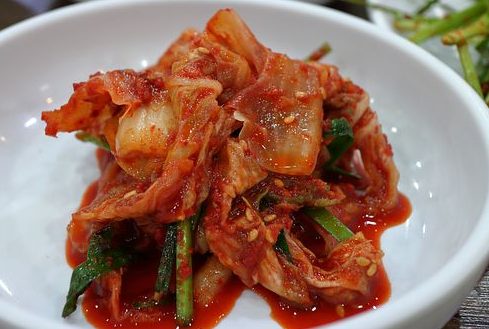Have you ever wondered what that bubbling is when you pop the lid on your jar of kimchi? Yep, it freaked me out the first time too! This is the kimchi releasing C02 gas as a bi-product. This is all part of the fermentation process as it creates its own vinegar to preserve the beneficial bacteria. This gives Kimchi its unique tangy flavour. Fermenting foods creates beneficial enzymes, b-vitamins, omega-3 fatty acids and various strains of probiotics. So fermented foods are great for the tummy and overall health. There has been a strong link between eating fermented foods and improved digestion. Making your own fermented foods is always best. It has been said that making your own kimchi develops the very bacteria your own gut needs!
Try this traditional Kimchi recipe from Maangchi:
Traditional Kimchi Ingredients
Makes about 8 pounds (3.6 kg) of Kimchi
For salting cabbage:
- 6 pounds napa cabbage (3 to 4 heads of medium napa cabbage)
- ½ cup Kosher salt
For making porridge:
- 2 cups water
- 2 tablespoons sweet rice flour (glutinous rice flour)
- 2 tablespoons turbinado sugar (or substitute with organic coconut sugar)
Vegetables:
- 2 cups radish matchsticks
- 1 cup carrot matchsticks
- 7 to 8 green onions, chopped
- 1 cup chopped Asian chives, optional (substitute with 3 green onions, chopped)
- 1 cup water dropwort (minari), optional
Seasonings and spices:
- ½ cup garlic cloves (24 garlic cloves), minced
- 2 teaspoon ginger, minced
- 1 medium onion, minced
- ½ cup fish sauce
- ¼ cup fermented salted shrimp (saeujeot) with the salty brine, chopped
- 2 cups hot pepper flakes
Directions
Prepare and salt the cabbage:
- If the cabbage cores stick out too much, trim them off.
- To split a cabbage in half without shredding the densely packed leaves inside, first cut a short slit in the base of the cabbage, enough to get a grip on either half and then gently pull the halves apart so the cabbage splits open.
- Cut a slit through the core of each half, 2 inches above the stem. You want the cabbage leaves to be loose but still attached to the core.
- Dunk the halves in a large basin of water to get them wet. Sprinkle the salt between the leaves by lifting up every leaf and getting salt in there. Use more salt closer to the stems, where the leaves are thicker.
- Let the cabbages rest for 2 hours. Turn over every 30 minutes so they get well salted. From time to time, you can ladle some of the salty water from the bottom of the basin over top of the cabbages if you want to.
- After 2 hours, wash the cabbage halves a few times under cold running water. Giving them a good wash to remove the salt and any dirt. As you wash, split the halves into quarters along the slits you cut into earlier. Cut off the cores, and put them in a strainer over a basin so they can drain well.
Prepare the porridge:
While the cabbage is salting for 2 hours, and in between the times you’re turning it over, you can make the porridge:
- Combine the water and the sweet rice flour in a small pot. Mix well with a wooden spoon and let it cook over medium heat for about 10 minutes until it bubbles. Add the sugar and cook for 1 more minute, stirring. Remove from the heat and let it cool off completely.
- Pour the cooled porridge into a large mixing bowl. Add garlic, ginger, onion, fish sauce, fermented salted shrimp, and hot pepper flakes. Mix well with the wooden spoon until the mixture turns into a thin paste.
- Add the radish, carrot, and green onion, plus the Asian chives (or more green onions) and the water dropwort if you’re using them. Mix well.
Make kimchi:
- Spread some kimchi paste on each cabbage leaf. When every leaf in a quarter is covered with paste, wrap it around itself into a small packet, and put it into your jar, plastic container, or onggi.
- Eat right away, or let it sit for a few days to ferment.
On fermentation:
- The kimchi will start fermenting a day or two at room temperature, depending on the temperature and humidity of your room. The warmer and more humid it is, the faster the kimchi will ferment. Once it starts to ferment it will smell and taste sour, and pressing on the top of the kimchi with a spoon will release bubbles from beneath.
- Once it ferments, store it in the refrigerator to use as needed. This slows down the fermentation process, which will make the kimchi more sour as time goes on.


